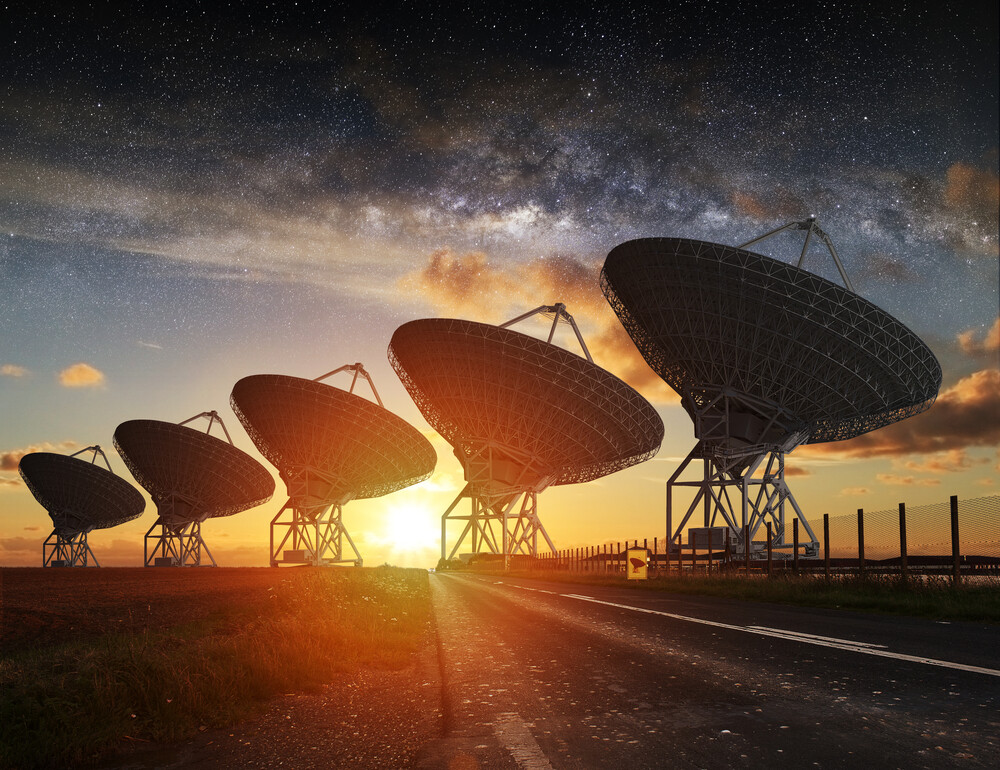Cracked Goes Galaxy Brain: 4 Bizarre Ways Aliens May Or May Not Look

Humanity's most important question, excluding pop media relationship statuses, Incognito rash inquiries, and whether or how various animals would wear pants, is this: are we alone? This one singular question comprises at least two questions but probably more. Because if we aren't alone, then how not alone just are we??? Are there any intelligent aliens we could have a brew and watch the game with, or are they all crabs?

NASA
If intelligent aliens exist, how common are they? Are these civilizations having drunken potlucks at some sort of Galactic Exchange? Or maybe they’re too rare and far apart to ever even know of each other, let alone become pals and share hobbies. Imagine a montage where we teach aliens to bicycle, fish, and throw a bitchin' slider while they teach us the art of existential mind-peace and the ancient, white-knuckle bloodsport of Bla-Gesh.
Don't Miss
Chillingly, we may be the gleaming example of advanced life in the entire universe. We're top of the mountain, baby. The universe has a long life ahead of it, a basically immeasurable one, and we're first up on the production line of thinking races. That'd be cool, but lonely. Also, consider the following …
It's Not Just What Other Life Looks Like, But How We See It
Plants are green because they reflect green light. But the chlorophyll that powers their photosynthetic planty prowesses is extra reflective in near-infrared. Sadly, we're limited to seeing the visible spectrum of light, which is a tiny portion of the entire spectrum.

Philip Ronan/Wikimedia Commons
But other creatures see more. Including mankind's closest-related species, the mole-crab people (Homo talpidae carcinos), whose eyes have gained infrared capabilities after generations of subterranean subsistence in our sewers. Also, they have claws for some reason. Why? Screw off, that's why. It's my alien comedy article, and I declaim claws on my crab-men … sexual selection, maybe? Ladies love a good claw.
But that's beside the point. If we were able to see a bit further into the spectrum, plants would appear to have a "red edge," and the world might look something like this:

It depends on what kind of light a star produces. Plants on other worlds would sop up whatever's good or plentiful, potentially turning the landscapes blue. Or, for plants looking up at puny stars from which all light must be absorbed, black.

Other life may look totally different while adhering to the same evolutionary principles. Here's a sampler platter of alien evolution:

– The first thingy is a basic, self-replicating molecule, possibly like the ones that featured on the low-down reaches of our tree of life billions of years ago. It "may or may not undergo natural selection" and is about as advanced as James Bond 007 for the Nintendo Game Boy entertainment system.
– The second thing is still incredibly simple yet more like an actual cell, thanks to a "contrivance of parts natural selection." It also looks like Gustav Klimt trying to draw a vagina.
– Then, once an alien species undergoes "major transitions," it may resemble the third character, with tiny horrible baby feet. Its umbrella appendage lures Señor Frog's patrons with the promise of tropical libations.
Or, we may stumble upon a bonafide "octomite," a colony of different squirmy bits. Kind of like a jellyfish, though in a jelly the various parts are specialized clones. In octo's case, they're just various things chilling together in a Freudian bonanza of orifices, prickliness, smells, and writhing, oozing excrescences.
Oh, boy, looking at these for any prolonged period makes one need a cigarette, and not in a good way. But it's beneficial for the soul to consider creepy creatures throughout the cosmos.
There's also a chance alien worlds could have Earth-similar things, like forests with terrestrial-shaped trees and cacti-studded deserts. But then again, maybe they'll have "zeppelin plants." These zephyr-riding plantsacks use hydrogen-filled bladders to float up and release their seeds from above.
Also, evolution could work independently from biology, chemistry, and biochemistry. So the universe could create familiar-looking life that utilizes completely wonky metabolism, some weird alternative to DNA, or non-water-based internal liquids, perhaps pineapple Fanta.
Aliens Could Look And Maybe Even Communicate Like Us, Dawg
Regarding convergent evolution, maybe nature isn't as creative as we thought and survival problems "only have a few good solutions." On Earth, different animals got wings, eyes, and other features independently. Like in Australia, a giant iron-reddened and sun-scorched crucible of mutation, where things like thylacines resembled wolves. But with pouches. Pouched wolves, son.
Counter-intuitively, this may suggest we're alone, according to an opinion-point that goes thus: the convergent examples happened along a single evolutionary line, the Eumetazoa, comprising basically all animals. These non-convergent examples are the most essential and happened only once. Life originated only once, as did photosynthesis, complex cells, sex, complicated animals, and intelligence. Often taking billions of years. We've won lottery after lottery. Also, they're crazy lotteries with not just numbers but Dingbat fonts and flavors of Ben & Jerry's.
Here's another lottery—living things come in two primary flavors: prokaryotes, like bacteria, which are single, super-simple cells. And eukaryotes, like animals, whose many cells have fancy features, a nucleus, and more complex DNA. But complex cells may only exist because simpler cells swallowed each other up billions of years ago. Maybe multiple times. The chances of this occurring elsewhere (functionally) are about as good as finding true love on OnlyFans.
Additionally, each lottery is many mini-lotteries. Photosynthesis necessitated loads of tweaks to many cell types, so plants produce oxygen and not, perhaps, farts. So, such intelligence as ours may occur on only 1 in 100 trillion habitable worlds. But while there may not be any civilizations in our galaxy, it's quite possible that the Milky Way still harbors tens of billions of planets covered in prokaryotic purple slime.
That may be a universal theme. Simpler life could be abundant, while intelligent life is rare. And again, we could be the only example of it in the cosmos, as little as one would assume it by perusing popular TV, music, literature, food, the subpar offerings of competing internet comedy sites, or social media nutmeg-huffing accounts.
Even if advanced beings are close, maybe we can't detect their presence. Ever. Their signals could be impossible for us to perceive. The Swarm is a collective spider-mind that communicates telepathically. Or maybe advanced alien messages don't "leak" out into space, or they interact through some weird interdimensional medium, like spectral farts. Their entire communications could be based on "pull my finger" jokes and therefore invisible to SETI's finest state-of-the-art telescopes.

Sdecoret/Shutterstock
Even if we chance across a signal or some ET radiation, we won't be able to decipher it. There'll be no way to know if it's a warp drive blueprint or the most scrumptious vegan oatmeal cookies you’ve ever tasted. ("Get more delicious recipes straight to your inbox by signing up today!) Even other signs of far-flung civilizations, like pollution or waste heat, may not exist because these beings are perfectly efficient with their resources.
They might be robots, or robotic brains the size of your city
The problem with organic "wet" brains is that they're limited by size and processing power. Similar challenges are faced by the organic “wet” under-parts that get so many of us in trouble today. But inorganic brains theoretically have no limits of perception or conception, and robotification may be the ultimate destiny of all lifeforms that don't nuke themselves into glowing dust.
Such entities could be billions of years beyond us. They might switch from being carbon-based to silicon-based. Like briefs to boxers, the shift is liberating. Silicon beings would have way better processing capabilities by basically turning themselves into computer chips. With no discernible bounds, a computerized intelligence could be city-sized or even planet-sized. Or all of that and voiced by Orson Wells.
Plus, silicon creatures would be practically immortal and likelier to brave the dangers of space exploration. Such beings could design their own descendants, becoming more enlightened with every generation, like a race of Buddhas with shoulder-missiles. Or they'll alter their current forms and birth no more generations.
But then again, who knows? Increased sophistication may also mean increased potential for complications. Scientists developing quantum computers are finding all sorts of surprising avenues for errors. Maybe advanced robotification is logistically impossible. Maybe the limit is semi-cyborgization, culminating in a still-squishy race with modifications like super-lungs, a cancer-proof colon, and mega-monster dongs.
We May Be All Alone
Or maybe advanced aliens don't look like anything because they don't exist. We may be the only intelligent (ish) life in the universe. Based on statistical models, Oxford researchers say "average evolutionary transition times likely exceed the lifetime of Earth." And the universe is only a few Earth-ages old.
Even around stable Sun-resembling stars, multiple evolutionary transitions are necessary. Each may require billions of years. In Oxford's models, there wasn't much difference between three or seven evolutionary transitions because anything beyond a few is so astronomically unlikely that the odds only go from "utter bleedin’ bollocks" to "utter bleedin' bollocks, mate."

It's exceptionally doubtful for even a few transitions to take place before hitting the "Great Filter," or theoretical barrier that sends advancing species back to Flintstones days or worse. Will this take the form of internecine nuclear war or ultra-immersive super-sexy virtual reality? No one knows. But we may find out soon.
Therefore, there may be no wise Eldened Ones to visit us from mild and temperate planets where kindly grandfather-species sway in rocking chairs puffing pipes, while mater strains hot farina in the kitchen.
My favorite theory? The one with the greatest potential for mindscrewiness: that aliens may, or may have initially, looked like us. They may even address us in English, which isn't crazy as it sounds. If they can traverse space, why couldn't they learn our language by jamming to Spotify in Moon orbit? Or pick up conversational '70s American-English from the Sears bra catalogs left on the Lunar surface by our early astronauts?
Finally, there's always the chance they may have endured similar social histories to ours, with their own Fertile Crescents, Renaissances, Hitlers, and Age of Memes. So when a flying saucer lands on Earth, don't be surprised if humanoids in Supreme hoodies Fortnite dance down the ramp and greet us with hits from their Sour Diesel vapes.
Top image: DanieleGay/Shutterstock
